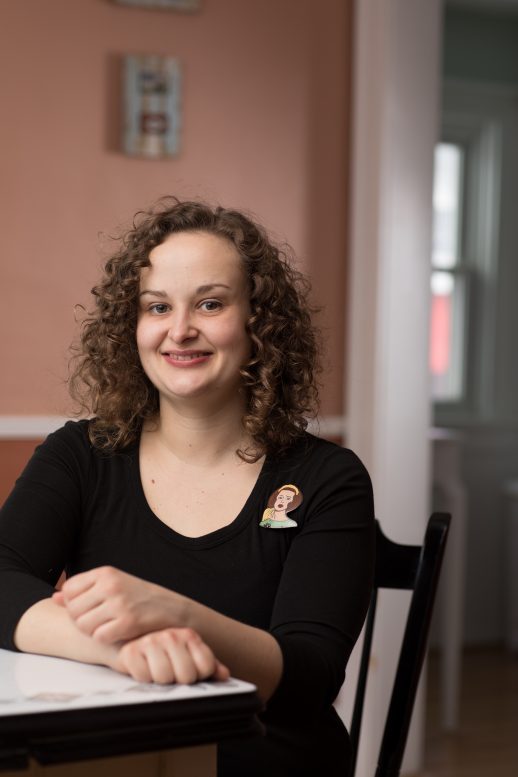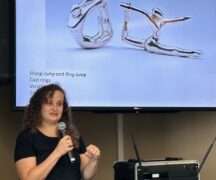By DAVID DUPONT
BG independent News
Marissa Saneholtz only has two smallish tattoos.
The women she depicts on her jewelry, though, are covered with ink.
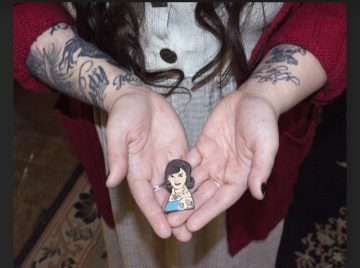
Model holds Marissa Saneholtz’s “She had decided that the time for waiting was over.” (Image provided)
Yet these women are depictions of the artist, proud assertions of her feminism. The copper and enamel broaches with decals fired into the surface that mix of social commentary, aesthetic grace, and technical mastery, have earned the Bowling Green native a place in Women to Watch Ohio – 2018. The show is now on exhibit in the Riffe Gallery in Columbus. The exhibit, which features the work of 10 women artists working in metals, is a collaboration of the Ohio Arts Council and the Ohio Advisory Group of the National Museum of Women in the Arts.
Saneholtz honed her skills close to home, first in the Bowling Green High and then at Bowling Green State University, before heading to East Carolina University to earn her Master of Fine Arts. After stints in Italy, Vail, Colorado, and at Appalachian State University, she’s back home as an instructor in the metals and jewelry program at BGSU’s School of Art.
Saneholtz, 32, said her art activity started from the time she came out of the womb. Her mother, Karen, did the arts projects for Plan, Do, and Talk. And when her daughter was a preschooler, she served as her “Guinea pig.” If she could do a project, the other kids could as well. When Saneholtz was older, she’d help her mother by demonstrating the projects.
At Bowling Green High School, she started in art inspired by teacher Becky Laabs. As a freshman, Saneholtz won a prize in a state competition. She thought, “I can do this.”
Academics came easily for her. “Art was good because I could challenge myself and research anything I wanted and turn it into art.”
Metalsmithing was a good fit. The process jibed with her talents in science and math. It takes logic and organization. It’s “very planned out,” Saneholtz said. Science meets art as she deals with patinas, melting temps and alloys. “That’s all really exciting.”
Using glass for enameling, she also has to consider fusion temperatures and expansion rates. “Not everyone wants to think about those things when they’re making art.”
When it came to going to college, she didn’t consider BGSU at first. “I didn’t want to be a townie.”
But looking around at metal and jewelry programs, BGSU’s program, directed by internationally recognized artist Tom Muir, rose to the top.
Saneholtz enrolled as an art education major. “I wanted to be exactly like Becky Laabs.”
But Muir talked her switching her major to metals. Muir’s sense of humor and penchant for telling stories were a good fit for Saneholtz, who displays the same qualities in her work.
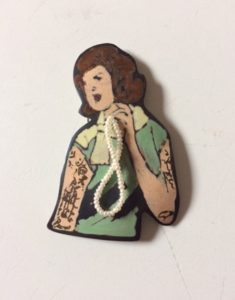
“She refused to let someone else dictate her sense of self worth” (Image provided)
That’s evident in the three broaches on display in Columbus, and it’s part of what attracted Ann Bremner, who curated the show with Matt Distel, to her jewelry.
Bremner said she did a lot of searching and research to find a jeweler in the show. She was attracted to Saneholtz pieces. “I found humor and craft. … I was really impressed with her and her work. This somebody I really want to talk to” especially given Saneholtz was an artist “just coming into her mature work.” So the curator traveled to Bowling Green to speak to Saneholtz.
“Her work is pointed and funny and intelligent,” Bremner said. It has layers of meaning. It reflects on the tradition of jewelry, which is “a very private and intimate art form.”
“Jewelry is something you wear and keep close to you,” the curator said. “It’s also something you wear facing out into world.” Saneholtz is “as willing to make political commentary as anyone doing any other art form.”
The figures themselves wear jewelry. In one, titled, “She refused to let someone else dictate her sense of self worth,” the woman dismissively holds a pearl necklace.
“The imagery I use is from 1950s comic books that were my mom’s,” Saneholtz said. “I’ve done a lot of research on the imagery and portrayal of women in media during period when suburbia started. … This was when this whole idea of the housewife came about.”
Those attitudes, she said, persist today.
The messages in those romance comics “were really pretty horrible most of the time in terms of empowerment of women.” The expectation was that a woman needed a man to validate her, and that a woman was expected to compromise her needs and goals to those of her husband.
“That’s not at all what I think of as my mother or myself,” Saneholtz said. “When I started thinking of what kind of imagery I wanted to represent me as a person I found myself going back to my mom, looking at what she was looking at.”
To supplement this she read dating guides and etiquette books and their contemporary counterparts. She was surprised how much overlap there was between what women were told in the 19650s and what Cosmo told them now, except now there are explicit sex tips on the next page. “It’s really weird” given “we’ve gone through three waves of feminism.”
Saneholtz went further back into popular culture to the 1890s to find feminist icons on an unlikely place, the tattooed women of the circus.
These stars of the circus side show presented men with a fantasy, and they made their living by displaying their bodies. But Betty Broadbent and others also achieved financial independence from men, which was highly unusual at the time.
They were in control of what they showed and what they got tattooed, Saneholtz said.
So the figures pulled from the romance comics, now have acquired tattoos based on those that adorned the bodies of the circus women. They also have an attitude that’s expressed in the titles. “I usually have pretty sarcastic titles,” Saneholtz said.
“I was wondering if those tattoos could be a first step for consciousness raising for those figures,” Bremner said of Saneholtz’s broaches: “It’s smart work, but it’s not just smart. She’s very, very thoughtful about her work, and she’s done reading and research and gives it a different meaning.”
Saneholtz will discuss these issues Thursday, June 14, at noon when she gives a talk in the gallery.
She said it wasn’t her plan to come back to live in Bowling Green, it just happened to be where the job was.
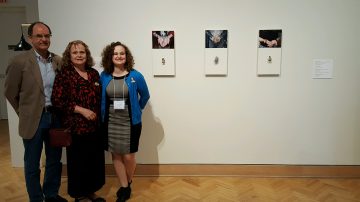
Marissa Saneholtz (right) with her parents, Dave and Karen Saneholtz, at the opening of Women to Watch Ohio (Image provided)
She came from Appalachian State where she had a one-year visiting position. Before then she worked with J. Cotter Galleries in Vail, Colorado. She was employed both in the gallery and in the studio creating jewelry sold in the gallery.
It was a different world. She got to work with precious jewels and metals that she’d not have otherwise been able to work with. She remembers showing a woman from Dubai a $16,000 white gold and diamond necklace. The woman put it on, and immediately inquired about what earrings she should buy to go with it.
The resort town was too rich for her blood, and beside she likes college towns with the infusion of energy from students.
The work with Cotter was an important step since so many of her students will work with galleries, she felt a need to understand how they operate.
“My end game is to become a better educator,” she said.
And given the support from the Ohio Council for the Arts, she said, “Ohio is so good for artists.”

